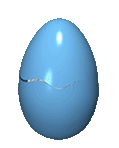
"The shell in fact amplifies the light - making the light source show much bigger," Dr. Dimitri Deheyn of the Scripps Institution of Oceanography in San Diego and leader of the study told state-funded BBC.
An expert in the study of bioluminescent organisms - living things that make their own light-, Dr. Deheyn says Hinea brasiliana is rather unique.
Among the many snails which he has worked on so far, this species is particular in that its green light still glows when it retracts into its opaque, yellow shell to avoid a predator.
Further studies exposed that the bright shell of the tiny creature had a far more effective "light diffuser" than the best commercially accessible product.
"It's also color-specific," Dr. Deheyn explained. "If you shine red light through it, it doesn't work; if you shine blue light it doesn't work.
"It only works for blue-green light that the snail produces."
Scientists say the snail's bioluminescence might have a more significant role than just scaring away predators.
The flashes, they think, put "the spotlight" on a persistent predator, such as a crab so that the creatures that prey on the crab can see it further easily.
This is known as the burglar alarm hypothesis in biology. "It could be the snail's way of saying, 'hey - eat that guy - he's attacking me'," said Dr. Deheyn.
The team is planning to study the shell in detail to find out more about its mechanism and perhaps copy its specialized light-amplifying structure.




















